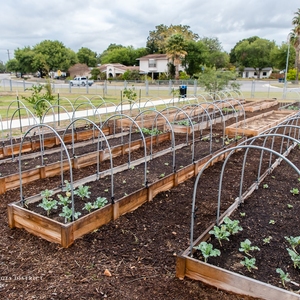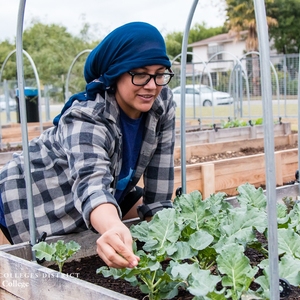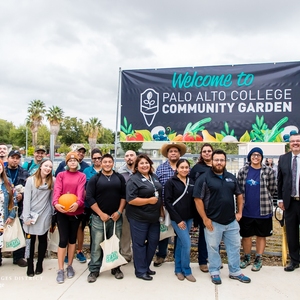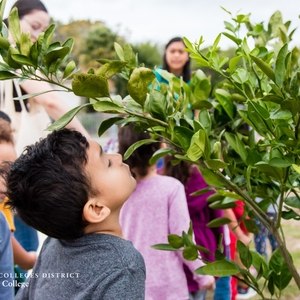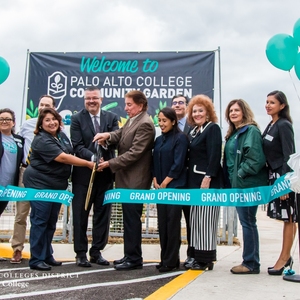Palo Alto College Community Garden
Palo Alto College
Project Overview
The Palo Alto Community Garden opened in October of 2019 as a space to grow food, cultivate community, and improve food security for the greater Palo Alto Community.
Background
In 2016, Palo Alto College launched a survey campaign to identify the most pressing issues for student retention and learning. The results showed that one of the most pressing issues was food insecurity. It is common in higher education that up to half of college students say they are not getting enough food to eat or they are worried about where their next meal will come from. In 2018, the Hope Center for College, Community and Justice released a report that estimates 41 percent of four-year university students who responded to the center’s survey are food insecure with the number even higher for community college students, at 48 percent. (The survey was sent to nearly 1.5 million students at 123 colleges and universities. Nearly 86,000 students responded). Palo Alto College serves a high non-traditional student population and in located in south Bexar County in San Antonio, where 52.5% of the population lives in poverty.
This concern caused Palo Alto College to partner with the San Antonio Food Bank to address the issue of student hunger with an on-campus food pantry and Community Garden for both students and community members. The on-campus food pantry and Community Garden are programs housed at the Student Health, Advocacy, Resource, and Engagement (S.H.A.R.E.) Center. Together, these services offer healthy and nutritious food for both students and their immediate family, which many times could mean the difference between staying in school or dropping out.
The neighborhoods surrounding Palo Alto College are considered a "food desert" — an area lacking access to healthy, affordable food found at grocery stores, farmers markets, and healthy food providers. According to the United States Department of Agriculture, food deserts are most often in underserved communities, such as south San Antonio. Programming at the garden aims to create a culture of sustainability by including educational components to inform the community about nutrition, gardening techniques, and space is available for community members to grow their own food and increase their food sovereignty. By providing increased access to nutritious, affordable food, our hope is that the Community Garden helps combat nutrition-related chronic health issues.
Creating an on-campus Community Garden also provided other opportunities. With San Antonio's close proximity to rural South Texas farming and ranching communities, Palo Alto College created a Horticulture and Agriculture program. The Community Garden allows students enrolled in these programs to gain hands-on experiential learning outside of the classroom that prepares them for real-world scenarios. On October 28, 2019, Palo Alto College officially opened the Palo Alto College Community Garden, to benefit both the student population and the surrounding community.
Goals
The mission of the Community Garden is to act as a space to grow food, cultivate community, and improve food security for the greater Palo Alto Community.
The goals of the Community Garden include:
Garden Goal 1. Provide horticulture and agriculture students with experiential learning experiences Activities: To support service learning, students from Palo Alto College’s Horticulture and Agriculture programs will help conduct monthly workshops to teach community members how to plant, maintain, and harvest the produce in the garden.
Garden Goal 2. Eradicate food insecurity on campus and the surrounding community by providing fresh grown produce to the on-campus food pantry and donations to the San Antonio Food Bank for community distribution Activities: At harvest time, community members and students can either keep the produce for themselves or donate it to the College’s food pantry or the San Antonio Food Bank.
Garden Goal 3. Combat nutrition-related chronic health issues by educating the community about the benefits of eating fresh produce and healthy living. Activities: Provide community workshops, events, workdays, and other engagement opportunities, with topics that include growing their own food, composting, and healthy living.
The goals of the Food Pantry include:
Pantry Goal 1. Providing access to food for low-income students, their families, and the community by building the capacity of PAC’s campus food pantry and food distribution program. Activities: Food fairs, and Food Pantry weekly hours for students and community members.
Pantry Goal 2. Organizing and promoting healthy lifestyle activities for PAC students and their families. Activities: Food demos, wellness workshops, resource fairs and referrals, gardening, and fitness programs.
Pantry Goal 3. Building capacity for the college’s Farmers Market. ** Activities: **Implementing monthly Farmer’s Markets
Implementation
Understanding the importance of combating food insecurity on campus and the surrounding community, the president of Palo Alto College designated space within S.H.A.R.E. center for an on-campus food pantry and a plot of land on campus for the Community Garden. The Community Garden was strategically located, near the northern outer boundary and adjacent to the Palo Alto College community park, known as Palomino Park, that includes a walking trail and sports fields. This location was chosen to draw in community members to learn about food sustainability, active lifestyles, and healthy living.
Palo Alto College applied and secured a Department of Education Title V Grant that provided the financial support to construct the on-campus food pantry and break ground on the garden. Together, these services provide educational opportunities for student service learning, community awareness, and the support of student basic needs.
To ensure institutional support and sustainability of the programs, a community advisory board was created and consists of a cross-college team that includes Co-Directors Rose Flores, Horticulture; Ty Chumbley, Agriculture; Erica Munoz, Student Life; Carlos Cruz, Student Life/AmeriCorps VISTA, and Joseph Coppola, Department Chair of Professional and Technical Education. The community advisory board provides oversight and guidance for the program.
Community partners include the United States Department of Agriculture (USDA), San Antonio Food Bank, and the City of San Antonio. Each of these partners provide financial and/or in-kind support as well as professionals to act as advisors, speakers, and community liaisons.
Title V funds also provided support for a Garden Coordinator position with duties that include: • Daily garden maintenance and upkeep of communal grounds, materials, tools, etc. • Garden Member recruitment, communication, documentation, and garden bed allocation. • Engage with on-campus staff and faculty to create events, lessons, workshops, and/or designated learning areas in the garden. • Engage with community organizations and partners to create events, lessons, and/or workshops in the garden. • Plan and lead sustainable, organic, environmentally conscience garden activities for all age groups. • Research and pursue grant and funding opportunities for sustaining the garden. • Develop a system for recruitment, training, coordination and tracking of volunteers. • Help plan seasonal events (Harvest Parties, Plant Swap, etc) for both on and off campus community members. • Secure donations, develop a summer maintenance plan, and host community garden work days and tours. • Maintain the Community Garden website by posting monthly updates and photos. • Assist in the design and maintenance of the school gardens and outdoor classroom space, supporting the preparation for garden work activities and planting schedule. • Coordinate with administration, waste removal systems, and community organizations to implement and sustain compost programming. • Collect and report data regarding community engagement, volunteer engagement, academic engagement, budget, workload, engagement satisfaction, food security and healthy futures measures (in partnership with AmeriCorps VISTA grant), additional grant measures, etc.
Students also have the opportunity to gain paid experience as an Academic Lab Tech Position. In 2021, anticipated summer employment will be available to students as college or district sponsored interns, interns from Upward Bound/TRiO programs, or interns from the City of San Antonio.
Timeline
• In October 2016, Palo Alto College secured a Department of Education Title V Impacto grant that provided the start-up funding for the on-campus food pantry and community garden.
• During 2017, activities consisted of planning, including the creation for the Garden Community Advisory Committee and alignment of the Community Garden proposed activities with the key competencies of the Palo Alto College horticulture and agriculture programs.
• 2018 and 2019 focused on developing partnerships with key stakeholders that include the USDA, the San Antonio Food Bank, and the City of San Antonio. This also included the design and construction phase of the community garden area.
• On October 28, 2019, the community garden was the opened. Activities throughout 2019 and 2020 included recruiting students and community members for garden plots, experiential and service learning opportunities for students through Community Garden Work Days, educational workshops on topics of composting, gardening, and healthy living, monthly work days (weeding), and PACsprouts events (where vegetable plants are sold as a fundraiser to the community and also bring awareness of sustainability and food security).
Financing
The on-campus food pantry and Community Garden were funded as part a five-year, $2.6 million grant from the U.S. Department of Education within the Project Impacto grant, which has supported various resources available through the College’s Student Health, Advocacy, Resource, and Engagement (S.H.A.R.E.) Center.
The cost of the on-campus food pantry consisted of the upfront cost of office space renovation in the amount of approximately $50,000. With an annual recurring cost of $131,000 that includes staff ($116,000), outreach ($3,500), and supplies/food ($11,500).
The cost of the Community Garden consisted of the upfront cost of construction of the Garden ($136,773) and the annual recurring cost of $42,000 that includes garden staff ($32,000) and garden materials and supplies ($10,000).
The food pantry and Community Garden are an addition to other campus initiatives to provide healthy food to students and the community, including biannual Food Fairs which are supported by the San Antonio Food Bank. As the Impacto grant comes to an end in 2020, Palo Alto College has institutionalized the services provided by the S.H.A.R.E. center, including the on-campus food pantry and Community Garden.
Results
The outcomes of the Community Garden are aligned with the goals. The outcomes as of September 20, 2019 (when volunteers began working on the garden) include:
Garden Goal 1. Provide horticulture and agriculture students with experiential learning experiences Outcome 1: Over 240 hours in service learning from Palo Alto College students participating in Community Garden events and activities.
Garden Goal 2. Eradicate food insecurity on campus and the surrounding community by providing fresh grown produce to the on-campus food pantry and donations to the San Antonio Food Bank for community distribution Outcome 2: Over 500 lbs. of produce was harvested and donated to the on-campus food pantry and the San Antonio Food Bank for Community Distribution
Garden Goal 3. Combat nutrition-related chronic health issues by educating the community about the benefits of eating fresh produce and healthy living Outcome 3: Served over 100 community members participated in workshops, workdays, and Community Garden engagement events to learn about eating fresh produce and healthy living.
The outcomes of the Food Pantry are also aligned with the goals.
Pantry Goal 1. Providing access to food for low-income students, their families, and the community by building the capacity of PAC’s campus food pantry and food distribution program. Outcome 1: Over 8,000 of individuals received support, education and/or referrals for hunger.
Pantry Goal 2. Organizing and promoting healthy lifestyle activities for PAC students and their families. Outcome 2: Over 2,000 individuals participated in Healthy Lifestyles Workshops, Demonstrations, and Events.
Pantry Goal 3. Building capacity for the college’s Farmers Market. Outcome 3: Monthly Farmers Market has been going strong since Dec. 2017. Each market includes healthy recipes, cooking demo, provides senior and WIC vouchers to community members, and over 200 pounds of fresh produce distributed for free.
Lessons Learned
Located in South Texas, the tendency of drought is common and having a permanent water source is crucial for successful harvest. Rather than relying on city water (which may have watering restrictions in times of drought) or rain catchment systems (which are unreliable due to droughts in the area), implementing a recycled water system would have been a good idea during the planning stage. This would ensure a permanent water source without the impacting the limited supply of drinking water in the area.

